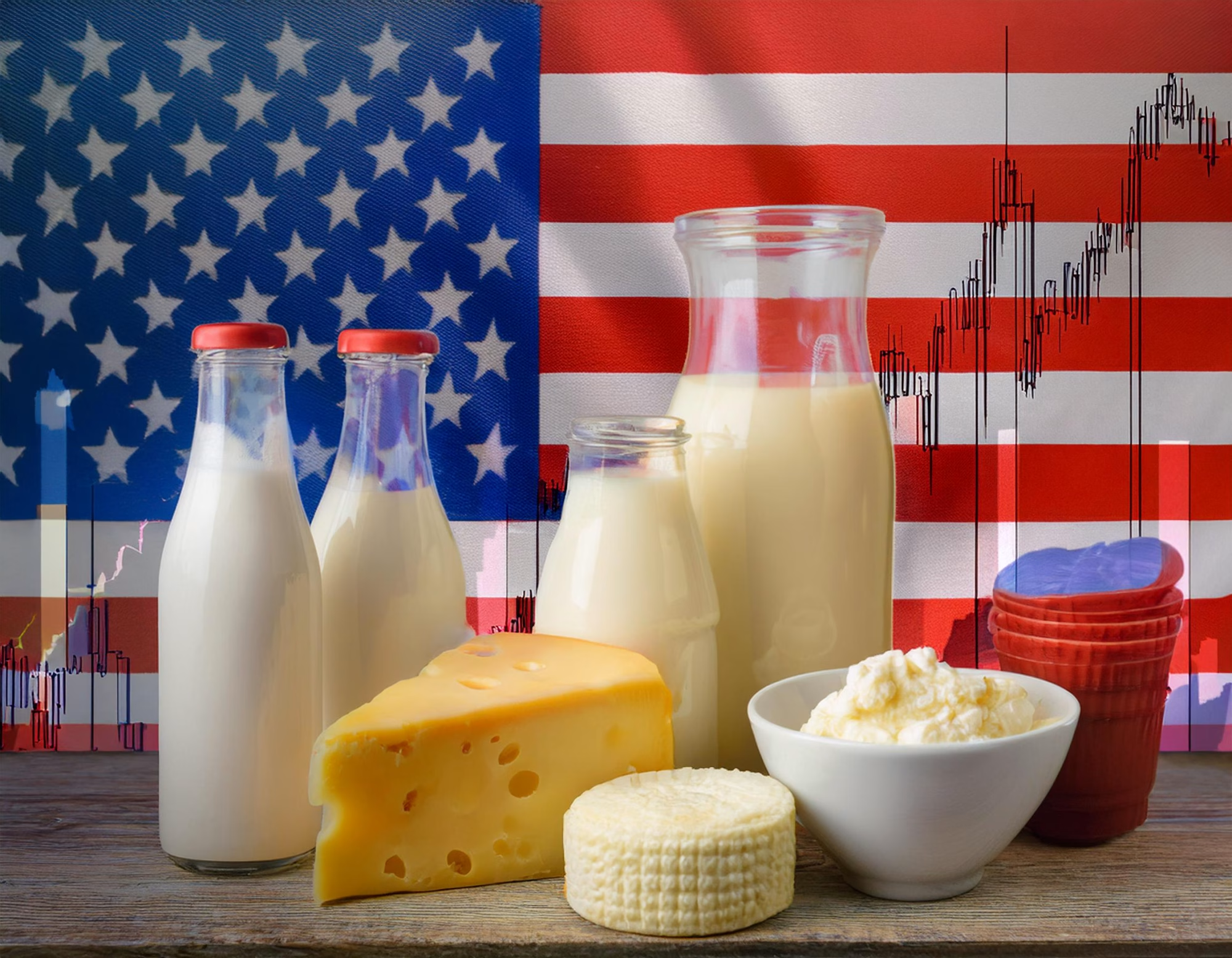New Zealand‘s dairy boom is boosting farmer profits with record milk collections and rising prices. Curious about the latest trends? Read on.
Summary: Seeing your milk collections rise this winter? You’re not alone. Due to favorable weather conditions, New Zealand’s dairy production has hit an all-time high for July. Milk volumes are up by 8.4%, and milk solids have also seen a 9.2% increase. This is great news for dairy farmers, especially with Fonterra upping its projected farmgate milk price to NZ$8.50/kg of milk solids. The industry is diversifying beyond whole milk powder (WMP) to focus more on skim milk powder (SMP), butter, and cheese, catering to evolving global demands and lessening reliance on the Chinese market. Challenges lie ahead, but profit opportunities have never looked more promising.
- New Zealand’s dairy production surged to an all-time high for July, with milk volumes up 8.4% and milk solids by 9.2%.
- Fonterra has increased the projected farmgate milk price to NZ$8.50/kg of milk solids.
- The dairy industry is diversifying its products to focus more on SMP, butter, and cheese, reducing its dependency on the Chinese market.
- This diversification aligns with global demand changes and presents new profit opportunities for dairy farmers.

In July, New Zealand had record-breaking milk collections, with volumes surpassing 310 thousand metric tons, up an impressive 8.4% from the previous year, and milk solids collections beating last year’s records by 9.2%. This spike makes July 2023 the most critical milk-producing month in history. Fonterra increased the predicted farmgate milk price by 50% to NZ$8.50/kg of milk solids, which is higher than the national average cost of milk production. This presents an ideal chance for dairy farmers to increase profitability. Understanding these patterns will help you make more educated choices and increase profits. Have you considered how this growing tendency may affect your dairy farm?
| Month | Milk Collections (Metric Tons) | Percent Change (Year-on-Year) |
|---|---|---|
| June | 280,000 | +7.5% |
| July | 310,000 | +8.4% |
| August | 330,000 | +9.0% |
Have you noticed a surge in your milk collections this winter?
July marked a historic milestone for Kiwi dairy producers. We achieved record levels with a remarkable 8.4% increase in milk collections over the previous year. This wasn’t just a minor uptick; it was the highest milk production ever recorded for July. Let’s take a moment to celebrate this significant achievement!
While June and July are typically slow, this year’s results defied expectations, setting a new benchmark for offseason output. These statistics underscore the resilience and effectiveness of New Zealand’s dairy sector. They are a strong indicator of the potential for future profitability and a prosperous season ahead, instilling confidence in our industry’s strength.
In New Zealand, June and July are typically the off-season for dairy production. This time enables cows to rest and recover before calving in the spring. Milk output often decreases during these months since most cows are dry. However, this year, a pleasant winter on the North Island has changed this tendency. Milk output started to rise sooner than predicted, providing farmers with a much-needed boost during a period when production often slows.
The Price-Upswing Farmers Have Been Waiting For
Following the August Global Dairy Trade (GDT) auctions, the dairy industry is optimistic. The surge in milk powder prices has sparked a wave of enthusiasm across the sector. We are poised for higher returns and improved season prospects with Fonterra’s 50% increase in the expected farmgate milk price, reaching a midpoint of NZ$8.50 per kilogram of milk solids. This is the price upswing we’ve been waiting for, and it’s time to seize the opportunities it presents.
However, the recent GDT auction had mixed outcomes. While skim milk powder (SMP) prices rose to their highest level since mid-June, whole milk powder (WMP) values declined. This mixed conclusion complicates planning in the following months.
New Zealand’s dairy industry is branching out.
The USDA’s most recent study expects a 6% reduction in whole milk powder (WMP) production this year. This decrease is sometimes good news. Instead, it allows for increased production of other dairy products. For example, skim milk powder (SMP) output is expected to grow by 9%, while butter production will increase by 3%.
These transitions occur at an appropriate moment. As demand for milk powder in China declines, the worldwide market for cheese grows. The USDA predicts that cheese output in New Zealand, which increased by 7% in 2023, will remain stable this year. This diversity helps to reduce risks and grasp new possibilities.
Take mozzarella, for example. Since its launch in December 2023, its price has increased by 28% at the most recent GDT auction. This surge indicates a good trend that may help balance the uneven results in the milk powder markets. Diversifying your product mix might help you adapt and profit from changing market needs.
Shifting Your Focus? You’re in Good Company
Have you found yourself having to adjust your production focus? You are not alone. Many dairy producers in New Zealand are pivoting to capitalize on new possibilities created by shifting global preferences. The industry is adjusting its product selection in response to a significant drop in Chinese demand for milk powder.
Take cheese, for example. The worldwide demand for cheese has never been greater, and it’s paying off. Mozzarella prices reached new highs during the last GDT auction, up 28% from the first sale in December 2023. This demand is a dazzling indication of fresh earnings waiting to be realized.
This strategy move is more than simply responding to current market developments; it is also about capitalizing on possible long-term profits. Diversifying into a more extensive product mix will allow you to position your firm to survive in the face of shifting demand. The stats speak for themselves.
Balancing Opportunities with Potential Challenges
While the recent jump in milk collections and projected price increases create a pleasant image, possible difficulties remain. Have you considered the consequences of shifting global demand? Dairy markets, notably in China, significantly affect pricing and demand. An unexpected decrease in Chinese demand for milk powder might interrupt the upward trend.
Then there’s the unpredictable beast called climate change. Although this winter has been mild, future seasons may not be so merciful. Unseasonal weather patterns may disrupt grazing conditions and milk production cycles, posing challenges for even the best-prepared farms.
Regulatory changes are another essential concern. New rules regarding animal welfare, environmental pollution, and commerce may all result in higher expenses or operational adjustments. Staying ahead of these regulatory developments necessitates changing your procedures and making financial investments.
In the fast-paced world of dairy production, it is critical to balance anticipated obstacles with present optimism. By being watchful and adaptable, you can overcome these obstacles while capitalizing on opportunities.
The Future of New Zealand’s Dairy Industry Looks Promising, But There Are Key Points You Should Keep an Eye On
Experts expect milk output to expand steadily over the next several years by 3-5% [Global Dairy Report]. This expansion may pave the path for increased total revenues, particularly if global demand continues to be robust.
Price patterns: Recent patterns suggest that milk prices are erratic but typically increasing. Rabobank analysts predict that the global milk price will range between USD 3.90 and 4.50 per kg by mid-2024, depending on various economic variables and trade dynamics. Keeping a careful watch on these industry developments might provide significant insights into increasing profit margins.
Market Opportunities: Diversification is a critical approach. Cheese, butter, and skim milk powder are becoming more popular worldwide. For example, the cheese industry alone is predicted to increase by about 7% yearly [Dairy Industry Analysis]. China’s changing milk powder demand creates attractive opportunities in Southeast Asia and Africa.
Expert Forecasts: “New Zealand’s dairy sector is robust and adapting well to global trends.” To maintain profitability, the emphasis should be on value-added goods and expanding into new markets, according to Michael Anderson, a prominent analyst at USDA [USDA]. Embracing innovation and being current on market projections will help you remain ahead of the competition.
New Zealand dairy producers may look forward to a sustainable and lucrative future using these insights and strategically managing production and marketing plans.
The Bottom Line
The dairy business in New Zealand is exhibiting encouraging signals of expansion and promise. With milk collections at record highs and Fonterra’s favorable pricing revisions, there is potential for increasing profitability. Diversifying products like cheese and butter helps meet shifting global needs and mitigate market swings.
Now, more than ever is the time to explore how these trends may help your business. Investigate strategies to leverage increased milk collections and broaden your product offerings. Invest carefully in infrastructure and technology to improve efficiency and productivity. By remaining knowledgeable and adaptive, you can position your farm to succeed in changing market conditions.
Optimism is in the air; use this opportunity to prepare and make the most of the future. Monitor market developments, be adaptable, and plan for success.
Learn more:
- Dairy Sector Debt Surges: Building Resilience Amid Rising New Zealand Dairy Farming Costs and Low Milk Prices
- Navigating the Waves: Dairy Producers Defy Challenges to Keep Barns Full Amid Soaring Milk Prices and Adverse Conditions
- Big Milk Checks and Low Feed Costs: A Profitable Summer for Dairy Producers
 Join the Revolution!
Join the Revolution!
Bullvine Daily is your essential e-zine for staying ahead in the dairy industry. With over 30,000 subscribers, we bring you the week’s top news, helping you manage tasks efficiently. Stay informed about milk production, tech adoption, and more, so you can concentrate on your dairy operations.







 Join the Revolution!
Join the Revolution!





